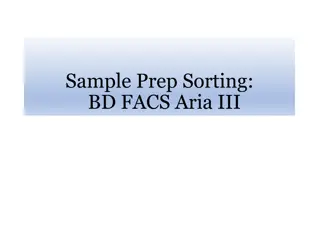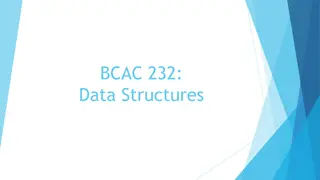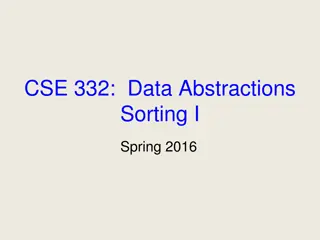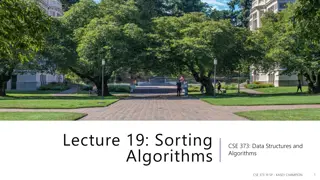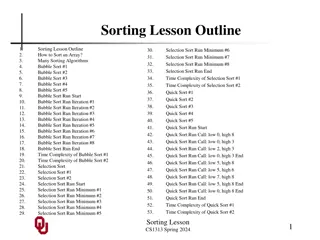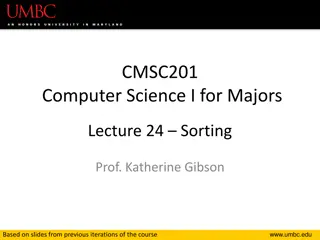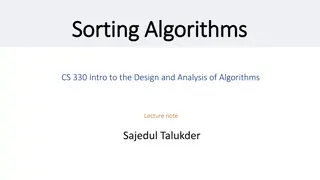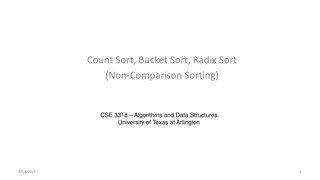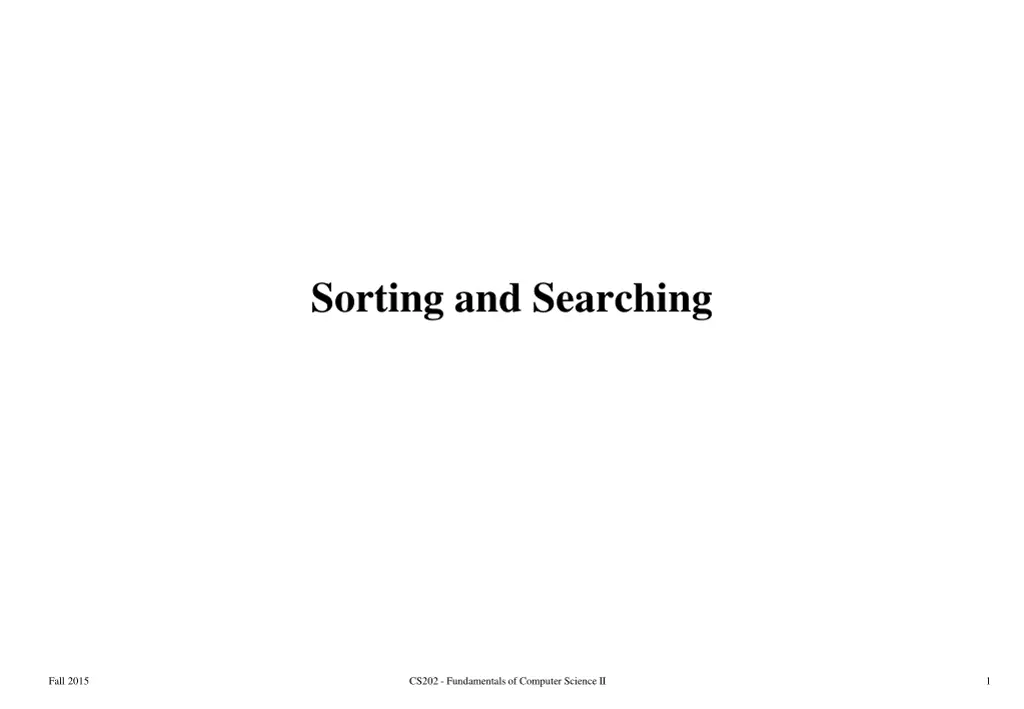
Fundamentals of Sorting and Searching in Computer Science
Explore the fundamentals of sorting and searching in computer science, covering topics such as sequential search, binary search, analysis of search algorithms, and the importance of sorting. Learn about the efficiencies of different algorithms and why sorting is a crucial aspect of computer science education.
Download Presentation

Please find below an Image/Link to download the presentation.
The content on the website is provided AS IS for your information and personal use only. It may not be sold, licensed, or shared on other websites without obtaining consent from the author. If you encounter any issues during the download, it is possible that the publisher has removed the file from their server.
You are allowed to download the files provided on this website for personal or commercial use, subject to the condition that they are used lawfully. All files are the property of their respective owners.
The content on the website is provided AS IS for your information and personal use only. It may not be sold, licensed, or shared on other websites without obtaining consent from the author.
E N D
Presentation Transcript
Sorting and Searching Fall 2015 CS202 - Fundamentals of Computer Science II 1
Problem of the Day Fall 2015 CS202 - Fundamentals of Computer Science II 2
Sequential Search int sequentialSearch( const int a[], int item, int n){ for (int i = 0; i < n && a[i]!= item; i++); if (i == n) return 1; return i; } Unsuccessful Search: O(n) Successful Search: Best-Case:item is in the first location of the array O(1) Worst-Case:item is in the last location of the array O(n) Average-Case: The number of key comparisons 1, 2, ..., n O(n) n n n = i + 2 ( / ) 2 n n = 1 i Fall 2015 CS202 - Fundamentals of Computer Science II 3
Binary Search int binarySearch( int a[], int size, int x) { int low =0; int high = size 1; int mid; // mid will be the index of // target when it s found. while (low <= high) { mid = (low + high)/2; if (a[mid] < x) low = mid + 1; else if (a[mid] > x) high = mid 1; else return mid; } return 1; } Fall 2015 CS202 - Fundamentals of Computer Science II 4
Binary Search Analysis For an unsuccessful search: The number of iterations in the loop is log2n + 1 O(log2n) For a successful search: Best-Case: The number of iterations is 1 Worst-Case: The number of iterations is log2n +1 O(log2n) Average-Case: The avg. # of iterations < log2n O(1) O(log2n) 0 1 2 3 4 5 6 7 an array with size 8 3 2 3 1 3 2 3 4 # of iterations The average # of iterations = 21/8 < log28 Fall 2015 CS202 - Fundamentals of Computer Science II 5
How much better is O(log2n)? n O(log2n) 4 6 8 10 14 17 18 19 20 30 16 64 256 1024 (1KB) 16,384 131,072 262,144 524,288 1,048,576 (1MB) 1,073,741,824 (1GB) Fall 2015 CS202 - Fundamentals of Computer Science II 6
Sorting Fall 2015 CS202 - Fundamentals of Computer Science II 7
Importance of Sorting Why don t CS profs ever stop talking about sorting? 1. Computers spend more time sorting than anything else, historically 25% on mainframes. 2. Sorting is the best studied problem in computer science, with a variety of different algorithms known. 3. Most of the interesting ideas we will encounter in the course can be taught in the context of sorting, such as divide-and-conquer, randomized algorithms, and lower bounds. (slide by Steven Skiena) Fall 2015 CS202 - Fundamentals of Computer Science II 8
Sorting Organize data into ascending / descending order Useful in many applications Any examples can you think of? Internal sort vs. external sort We will analyze only internal sorting algorithms Sorting also has other uses. It can make an algorithm faster. e.g., find the intersection of two sets Fall 2015 CS202 - Fundamentals of Computer Science II 9
Efficiency of Sorting Sorting is important because that once a set of items is sorted, many other problems become easy. Further, using O(n log n) sorting algorithms leads naturally to sub- quadratic algorithms for these problems. Large-scale data processing would be impossible if sorting took O(n2) time. (slide by Steven Skiena) Fall 2015 CS202 - Fundamentals of Computer Science II 10
Applications of Sorting Closest Pair: Given n numbers, find the pair which are closest to each other. Once the numbers are sorted, the closest pair will be next to each other in sorted order, so an O(n) linear scan completes the job. Complexity of this process: O(??) Element Uniqueness: Given a set of n items, are they all unique or are there any duplicates? Sort them and do a linear scan to check all adjacent pairs. This is a special case of closest pair above. Complexity? Mode: Given a set of n items, which element occurs the largest number of times? More generally, compute the frequency distribution. How would you solve it? Fall 2015 CS202 - Fundamentals of Computer Science II 11
Sorting Algorithms There are many sorting algorithms, such as: Selection Sort Insertion Sort Bubble Sort Merge Sort Quick Sort First three sorting algorithms are not so efficient, but last two are efficient sorting algorithms. Fall 2015 CS202 - Fundamentals of Computer Science II 12
Selection Sort Fall 2015 CS202 - Fundamentals of Computer Science II 13
Selection Sort List divided into two sublists, sorted and unsorted. Find the biggest element from the unsorted sublist. Swap it with the element at the end of the unsorted data. After each selection and swapping, imaginary wall between the two sublists move one element back. Sort pass: Each time we move one element from the unsorted sublist to the sorted sublist, we say that we have completed a sort pass. A list of n elements requires n-1 passes to completely sort data. Fall 2015 CS202 - Fundamentals of Computer Science II 14
Selection Sort (cont.) Unsorted Sorted Fall 2015 CS202 - Fundamentals of Computer Science II 15
Selection Sort (cont.) typedef type-of-array-item DataType; void selectionSort( DataType theArray[], int n) { for (int last = n-1; last >= 1; --last) { int largest = indexOfLargest(theArray, last+1); swap(theArray[largest], theArray[last]); } } Fall 2015 CS202 - Fundamentals of Computer Science II 16
Selection Sort (cont.) int indexOfLargest(const DataType theArray[], int size) { int indexSoFar = 0; for (int currentIndex=1; currentIndex<size;++currentIndex) { if (theArray[currentIndex] > theArray[indexSoFar]) indexSoFar = currentIndex; } return indexSoFar; } -------------------------------------------------------- void swap(DataType &x, DataType &y) { DataType temp = x; x = y; y = temp; } Fall 2015 CS202 - Fundamentals of Computer Science II 17
Selection Sort -- Analysis To analyze sorting, count simple operations For sorting, important simple operations: key comparisons and number of moves In selectionSort() function, the for loop executes n-1 times. In selectionSort() function, we invoke swap() once at each iteration. Total Swaps: n-1 Total Moves: 3*(n-1) (Each swap has three moves) Fall 2015 CS202 - Fundamentals of Computer Science II 18
Selection Sort Analysis (cont.) In indexOfLargest() function, the for loop executes (from n-1 to 1), and each iteration we make one key comparison. # of key comparisons = 1+2+...+n-1 = n*(n-1)/2 So, Selection sort is O(n2) The best case, worst case, and average case are the same all O(n2) Meaning: behavior of selection sort does not depend on initial organization of data. Since O(n2) grows so rapidly, the selection sort algorithm is appropriate only for small n. Although selection sort requires O(n2) key comparisons, it only requires O(n) moves. Selection sort is good choice if data moves are costly but key comparisons are not costly (short keys, long records). Fall 2015 CS202 - Fundamentals of Computer Science II 19
Insertion Sort Fall 2015 CS202 - Fundamentals of Computer Science II 20
Insertion Sort Insertion sort is a simple sorting algorithm appropriate for small inputs. Most common sorting technique used by card players. List divided into two parts: sorted and unsorted. In each pass, the first element of the unsorted part is picked up, transferred to the sorted sublist, and inserted in place. List of n elements will take at most n-1 passes to sort data. Fall 2015 CS202 - Fundamentals of Computer Science II 21
Insertion Sort (cont.) Sorted Unsorted 23 78 45 8 32 56 Original List After pass 1 23 78 45 8 32 56 23 45 78 8 32 56 After pass 2 After pass 3 8 23 45 78 32 56 After pass 4 8 23 32 45 78 56 After pass 5 8 23 32 45 56 78 Fall 2015 CS202 - Fundamentals of Computer Science II 22
Insertion Sort (cont.) void insertionSort(DataType theArray[], int n) { for (int unsorted = 1; unsorted < n; ++unsorted) { DataType nextItem = theArray[unsorted]; int loc = unsorted; for ( theArray[loc] = theArray[loc-1]; ;(loc > 0) && (theArray[loc-1] > nextItem); --loc) theArray[loc] = nextItem; } } Fall 2015 CS202 - Fundamentals of Computer Science II 23
Insertion Sort Analysis What is the complexity of insertion sort? Depends on array contents Best-case: Array is already sorted in ascending order. Inner loop will not be executed. The number of moves: 2*(n-1) The number of key comparisons: (n-1) Worst-case: Array is in reverse order: Inner loop is executed p-1 times, for p = 2,3, , n The number of moves: 2*(n-1)+(1+2+...+n-1)= 2*(n-1)+ n*(n-1)/2 The number of key comparisons: (1+2+...+n-1)= n*(n-1)/2 Average-case: O(n2) We have to look at all possible initial data organizations. So, Insertion Sort is O(n2) O(n) O(n) O(n) O(n2) O(n2) O(n2) Fall 2015 CS202 - Fundamentals of Computer Science II 24
Insertion Sort Analysis Which running time will be used to characterize this algorithm? Best, worst or average? Worst case: Longest running time (this is the upper limit for the algorithm) It is guaranteed that the algorithm will not be worst than this. Sometimes we are interested in average case. But there are problems: Difficult to figure out average case. i.e. what is the average input? Are we going to assume all possible inputs are equally likely? In fact, for most algorithms average case is the same as the worst case. Fall 2015 CS202 - Fundamentals of Computer Science II 25
Bubble Sort Fall 2015 CS202 - Fundamentals of Computer Science II 26
Bubble Sort List divided into two sublists: sorted and unsorted. The largest element is bubbled from the unsorted list and moved to the sorted sublist. After that, the wall moves one element back, increasing the number of sorted elements and decreasing the number of unsorted ones. One sort pass: each time an element moves from the unsorted part to the sorted part. Given a list of n elements, bubble sort requires up to n-1 passes (maximum passes) to sort data. Fall 2015 CS202 - Fundamentals of Computer Science II 27
Bubble Sort (cont.) Fall 2015 CS202 - Fundamentals of Computer Science II 28
Bubble Sort (cont.) void bubbleSort( DataType theArray[], int n) { bool sorted = false; for (int pass = 1; (pass < n) && !sorted; ++pass) { sorted = true; for (int index = 0; index < n-pass; ++index) { int nextIndex = index + 1; if (theArray[index] > theArray[nextIndex]) { swap(theArray[index], theArray[nextIndex]); sorted = false; // signal exchange } } } } Fall 2015 CS202 - Fundamentals of Computer Science II 29
Bubble Sort Analysis Worst-case: Array is in reverse order: Inner loop is executed n-1 times, The number of moves: 3*(1+2+...+n-1) = 3 * n*(n-1)/2 The number of key comparisons: (1+2+...+n-1)= n*(n-1)/2 Best-case: O(n) Array is already sorted in ascending order. The number of moves: 0 The number of key comparisons: (n-1) Average-case: O(n2) We have to look at all possible initial data organizations. So, Bubble Sort is O(n2) O(n2) O(n2) O(n2) O(1) O(n) Fall 2015 CS202 - Fundamentals of Computer Science II 30
Merge Sort Fall 2015 CS202 - Fundamentals of Computer Science II 31
Mergesort One of two important divide-and-conquer sorting algorithms Other one is Quicksort It is a recursive algorithm. Divide the list into halves, Sort each half separately, and Then merge the sorted halves into one sorted array. Fall 2015 CS202 - Fundamentals of Computer Science II 32
Mergesort - Example Fall 2015 CS202 - Fundamentals of Computer Science II 33
Mergesort void mergesort( DataType theArray[], int first, int last) { if (first < last) { int mid = (first + last)/2; // index of midpoint mergesort(theArray, first, mid); mergesort(theArray, mid+1, last); // merge the two halves merge(theArray, first, mid, last); } } // end mergesort Fall 2015 CS202 - Fundamentals of Computer Science II 34
Merge const int MAX_SIZE = maximum-number-of-items-in-array; void merge( DataType theArray[], int first, int mid, int last) { DataType tempArray[MAX_SIZE]; int first1 = first; // beginning of first subarray int last1 = mid; // end of first subarray int first2 = mid + 1; // beginning of second subarray int last2 = last; // end of second subarray int index = first1; // next available location in tempArray // temporary array for ( ; (first1 <= last1) && (first2 <= last2); ++index) { if (theArray[first1] < theArray[first2]) { tempArray[index] = theArray[first1]; ++first1; } else { tempArray[index] = theArray[first2]; ++first2; } } Fall 2015 CS202 - Fundamentals of Computer Science II 35
Merge (cont.) // finish off the first subarray, if necessary for (; first1 <= last1; ++first1, ++index) tempArray[index] = theArray[first1]; // finish off the second subarray, if necessary for (; first2 <= last2; ++first2, ++index) tempArray[index] = theArray[first2]; // copy the result back into the original array for (index = first; index <= last; ++index) theArray[index] = tempArray[index]; } // end merge Fall 2015 CS202 - Fundamentals of Computer Science II 36
Mergesort - Example 6 3 9 1 5 4 7 2 divide 6 3 9 1 5 4 7 2 divide divide 7 2 6 3 9 1 5 4 divide divide divide divide 6 3 9 1 5 4 7 2 merge merge merge merge 2 7 3 6 1 9 4 5 merge merge 1 3 6 9 2 4 5 7 merge 1 2 3 4 5 6 7 9 Fall 2015 CS202 - Fundamentals of Computer Science II 37
Mergesort Example2 Fall 2015 CS202 - Fundamentals of Computer Science II 38
Mergesort Analysis of Merge A worst-case instance of the merge step in mergesort Fall 2015 CS202 - Fundamentals of Computer Science II 39
Mergesort Analysis of Merge (cont.) 0 k-1 0 k-1 Merging two sorted arrays of size k .......... .......... 0 2k-1 .......... Best-case: All the elements in the first array are smaller (or larger) than all the elements in the second array. The number of moves: 2k + 2k The number of key comparisons: k Worst-case: The number of moves: 2k + 2k The number of key comparisons: 2k-1 Fall 2015 CS202 - Fundamentals of Computer Science II 40
Mergesort - Analysis Levels of recursive calls to mergesort, given an array of eight items Fall 2015 CS202 - Fundamentals of Computer Science II 41
Mergesort - Analysis 2m level 0 : 1 merge (size 2m-1) 2m-1 2m-1 level 1 : 2 merges (size 2m-2) level 2 : 4 merges (size 2m-3) 2m-2 2m-2 2m-2 2m-2 . . . . . . level m-1 : 2m-1 merges (size 20) 20 20 . . . . . . . . . . . . . . . . . level m Fall 2015 CS202 - Fundamentals of Computer Science II 42
Mergesort - Analysis Worst-case The number of key comparisons: = 20*(2*2m-1-1) + 21*(2*2m-2-1) + ... + 2m-1*(2*20-1) = (2m - 1) + (2m - 2) + ... + (2m 2m-1) ( m terms ) 1 m = i = m*2m i 2 0 = m*2m 2m 1 = n * log2n n 1 O (n * log2n ) Fall 2015 CS202 - Fundamentals of Computer Science II 43
Mergesort Average Case 2 k There are possibilities when sorting two sorted lists of size k. k ! 4 4 k=2 = = 6 different cases 2 ! 2 !* 2 # of key comparisons = ((2*2)+(4*3)) / 6 = 16/6 = 2 + 2/3 Average # of key comparisons in mergesort is n * log2n 1.25*n O(1) O (n * log2n ) Fall 2015 CS202 - Fundamentals of Computer Science II 44
Mergesort Analysis Mergesort is extremely efficient algorithm with respect to time. Both worst case and average cases are O (n * log2n ) But, mergesort requires an extra array whose size equals to the size of the original array. If we use a linked list, we do not need an extra array But, we need space for the links And, it will be difficult to divide the list into half ( O(n) ) Fall 2015 CS202 - Fundamentals of Computer Science II 45
Quicksort Fall 2015 CS202 - Fundamentals of Computer Science II 46
Quicksort Like Mergesort, Quicksort is based on divide-and-conquer paradigm. But somewhat opposite to Mergesort Mergesort: Hard work done after recursive call Quicksort: Hard work done before recursive call Algorithm 1. First, partition an array into two parts, 2. Then, sort each part independently, 3. Finally, combine sorted parts by a simple concatenation. Fall 2015 CS202 - Fundamentals of Computer Science II 47
Quicksort (cont.) The quick-sort algorithm consists of the following three steps: 1. Divide: Partition the list. 1.1 Choose some element from list. Call this element the pivot. - We hope about half the elements will come before and half after. 1.2 Then partition the elements so that all those with values less than the pivot come in one sublist and all those with greater values come in another. 2. Recursion: Recursively sort the sublists separately. 3. Conquer: Put the sorted sublists together. Fall 2015 CS202 - Fundamentals of Computer Science II 48
Partition Partitioning places the pivot in its correct place position within the array. Arranging elements around pivot p generates two smaller sorting problems. sort left section of the array, and sort right section of the array. when these two smaller sorting problems are solved recursively, our bigger sorting problem is solved. Fall 2015 CS202 - Fundamentals of Computer Science II 49
Partition Choosing the pivot First, select a pivot element among the elements of the given array, and put pivot into first location of the array before partitioning. Which array item should be selected as pivot? Somehow we have to select a pivot, and we hope that we will get a good partitioning. If the items in the array arranged randomly, we choose a pivot randomly. We can choose the first or last element as a pivot (it may not give a good partitioning). We can use different techniques to select the pivot. Fall 2015 CS202 - Fundamentals of Computer Science II 50

